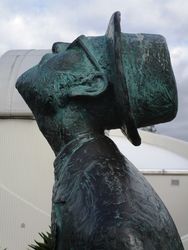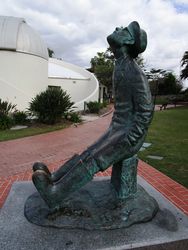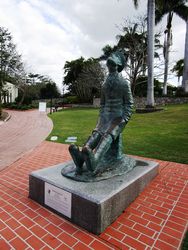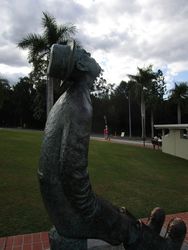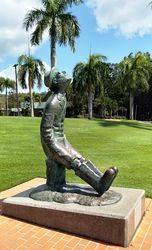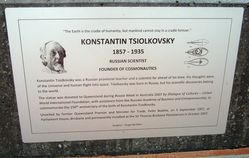
Home » Themes » People » Foreigners
Konstantin TsiolkovskyPrint Page 
The sculpture commemorates the 150th anniversary of the birth of the Russian scientist, and founder of cosmonautics, Konstantin Tsiolkovsky.
He was born on 17th September 1857, in Izhevskoye, Russia ; the son of a Polish deportee to Siberia. At age ten he nearly became deaf from scarlet fever and had to quit school. He refused to be handicapped by his deafness and continued his education on his own at home. His family recognized his thirst for knowledge and sent him to Moscow to attend college. He was accomplished in both science and mathematics and became a teacher at Kaluga, Russia.
He read Jules Verne's stories of space travel and began to write science fiction stories himself. He introduced elements of science and technology into his stories, such as the problem of controlling a rocket as it moved between gravitational fields. Gradually Tsiolkovsky moved from writing science fiction to writing theoretical papers on topics such as gyroscopes, escape velocities, the principle of action and reaction, and the use of liquid propellant rockets.
In 1894 Tsiolkovsky designed a monoplane that was not flown until 1915. He built the first Russian wind tunnel in 1897. He also was an insightful visionary who thought a great deal about the uses of his beloved rockets to explore and master space. He was the author of Investigations of Outer Space by Rocket Devices (1911) and Aims of Astronauts (1914). Although rockets had been in use since their invention in twelfth-century China as weapons that evolved from fireworks, it was Tsiolkovsky who used mathematics and physics to study and model the manner in which they operated, called rocket dynamics. In 1903 he published the rocket equation in a Russian aviation magazine. Called the Tsiolkovsky formula, it established the relationships among rocket speed, the speed of the gas at exit, and the mass of the rocket and its propellant. This equation is the basis of much of the spacecraft engineering done today. In 1929 he published his theory of multistage rockets, based on his knowledge of propulsion dynamics.
Tsiolkovsky is remembered for believing in the dominance of humanity throughout space, also known as anthropocosmism. He had grand ideas about space industrialization and the exploitation of its resources. Tsiolkovsky has been honored since his death in 1935. A far side moon crater is named in his honor. In 1989 he was invested in the International Aerospace Hall of Fame. The Konstantin E. Tsiolkovsky State Museum of the History of Cosmonautics in Kaluga, Russia, keeps the importance of his theoretical work before the public. In Russia, Konstantin Tsiolkovsky is called "the father of theoretical and applied cosmonautics." Although the Romanian Oberth and the American Goddard conducted similar research and arrived at comparable conclusions, there is no evidence that each knew details of the other's work. Therefore, all three of these scientists share the title of Father of Rocketry.
Location
| Address: | Mount Coot-tha Road, Sir Thomas Brisbane Planetarium, Brisbane Botanic Gardens, Mount Coot-tha, 4066 |
|---|---|
| State: | QLD |
| Area: | Foreign |
| GPS Coordinates: | Lat: -27.475448 Long: 152.976804 Note: GPS Coordinates are approximate. |
Details
| Monument Type: | Sculpture |
|---|---|
| Monument Theme: | People |
| Sub-Theme: | Foreigners |
| Artist: | Sergei Bychkov |
Dedication
| Actual Monument Dedication Date: | Wednesday 5th September, 2007 |
|---|
"The Earth is the cradle of humanity, but mankind cannot stay in the cradle forever."
Konstantin Tsiolkovsky
1857 - 1935
Russian Scientist
Founder of Cosmonautics
Konstantin Tsiolkovsky was a Russian provincial teacher and a scientist far ahead of his time. His thoughts were of the Universe and human flight into space. Tsiolkovsky was born in Russia, but his scientific discoveries belong to the world.
The statue was donated to Queensland during Russia Week in Australia 2007 by Dialogue of Cultures - United World International Foundation, with the assistance from the Russian Academy of Business and Entrepreneurship, to commemorate the 150th anniversary of the birth of Konstantin Tsiolkovsky.
Unveiled by former Queensland Premier and Minister for Trade, Peter Beattie, on 5 September 2007, at Parliament House, Brisbane and permanently installed at the Sir Thomas Brisbane Planetarium in October 2007
Sculptor - Sergei Bychkov


